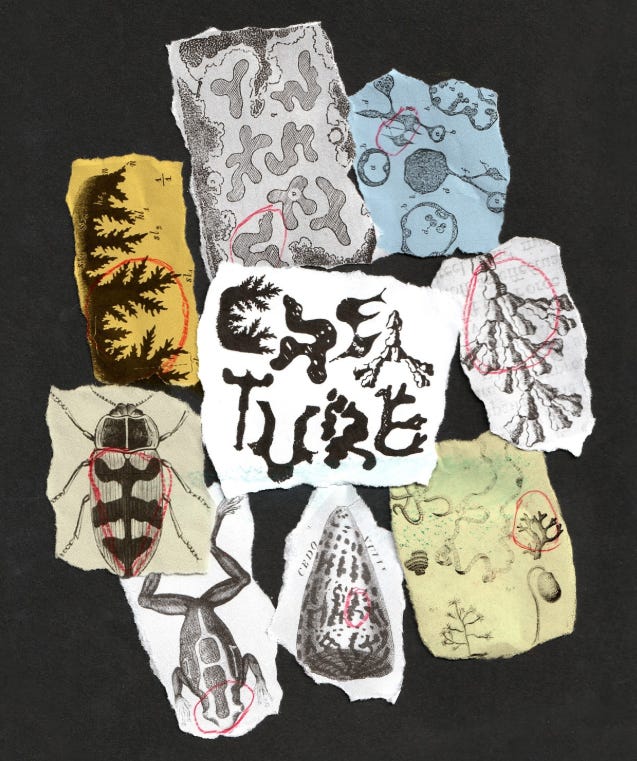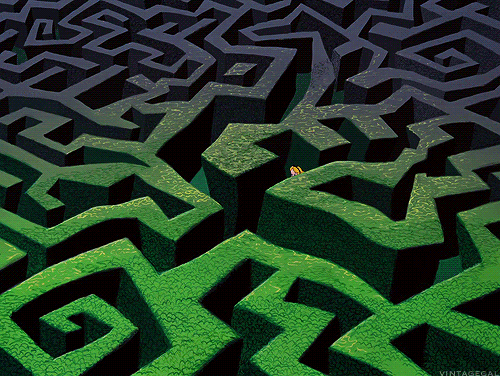‘The Minotaur embodies the fear of the different body, of desire outside the norm, condemned to wander in a labyrinth without exit. His very existence is a reminder of how societies create and exclude their own monsters.’
SCENT
‘Creature is a Brooklyn-based fragrance brand that celebrates the connection between nature and the human spirit. The fragrances are deeply personal, rooted in nature, and crafted with ingredients derived entirely from natural sources’.
Last year I won a perfume from creature.on.earth as a raffle prize during a fundraiser for the palestinian family Abu Shrar. Since then, I’ve had the pleasure of meeting the independent founder Navya Dev who has been slowly concocting a custom scent that I’m gifting to my partner.
Every fragrance is created in small batches and the caps are handmade by Navya and her partner. I adore the new branding which her collaborator Max Amato explains:
‘Each letterform is made up completely of elements found in the natural world, the same way that the fragrances are. The process involved digging through scans from biology encyclopedias, finding hints of typography in flowers, leaves, tree bark, beetles, animal patterns, and cellular structures, and then tracing, altering, and rearranging until we had a logo that felt like a living thing.’
SIGHT
This video succinctly illustrates the science behind the minotaur, how humans have used mythology to explain natural phenomena, and how geology informs story. Mariola Rosario was the first person to introduce me to this tale and she so eloquently expands on this perspective:
‘In Greek myth, the underworld isn’t always a metaphor or a Jungian motif. It’s often a place with coordinates, a crack in the hillside, a cave mouth, a river tunnel that leads elsewhere. There are many known entrances to Hades in the ancient Mediterranean imagination, many of them tied to real geological features. Some of which can still be found today.
It makes me wonder: what if this myth was seeded by the terrain itself? What if the story…was not only told in words, but written into the folds and ruptures of the land?
A topography of descent….A terrain of memory and rupture…becomes more than a geological phenomenon. It becomes a portal….An invitation to consider the earth not as stable ground, but as something living, shifting, reactive.
The body, like the earth, has places that open when touched. Places that ache. Places that remember.
Myths often carry the residue of the places that birthed them. They hold the climate. The soil. The seasonal rhythms. And they shift depending on where we stand. These aren’t simply allegories. They’re agricultural cycles, expressions of earth-based survival and storytelling.
Myth, then, is not a fixed inheritance. It is alive in territory. It is shaped by water, heat, and stone. In the same way, it can be reshaped by us, by where we are standing in the world, and how we listen and where we listen from.’
SOUND
It’s been over a decade since I last attempted to read Jorge Luis Borges. I was too young to fully understand ‘El Aleph’ in high school but I’ve been pulled back into his short stories, absorbed by his words. Spanish may be the colonizer’s tongue but Latin American writers have made magic with this language just the same. There’s a resonance from hearing his poetry in its original form, fragments that get lost in translation, the translator is a traitor.
Escucha: El Laberinto, La Casa de Asterión, Los Dos Reyes y Los Dos Laberintos, Otro Poema de los Dones, El Jardín de Senderos que se Bifurcan, y La Biblioteca de Babel.
If you’d prefer an english audio, most of the poems & essays linked above can be found online. Or I’d suggest this podcast that traces the labyrinth back to the Bronze Age (2500 to 2000 BC) and explores its historical & modern symbology.
‘Confusion, wandering, isolation, darkness, disorientation—all evoke the labyrinth, a complex network of paths in which it is difficult to find one’s way out. Or do they? The labyrinth’s original meaning has been entirely distorted, which is only to be expected from such a perplexing symbol… The archetypal image of the labyrinth fundamentally expresses the path of life, full of dark corners and unexpected turns. If we overcome them, we are transformed and enlightened – if not, we become disoriented and find life meaningless.’
TASTE
What else goes through putrefaction, transmogrification, ebullition, and underground resurgence like fermentation? There are biological ties between the minotaur’s milk & spontaneous fermentation. The ruminant stomach of cows (and other hoofed animals) occupies 75% of their abdominal cavity. The part of their digestive system called the rumen serves as a fermentation vat that breaks down their feed.
If you’re looking to literally ingest this mythos, check out Joan Didion’s sauerkraut recipe or the Five Points Fermentation Company which brings probiotics to the people, but I have a few quotes as food for thought:
‘The alchemical wisdom of fermentation invites an effervescent death to bubble up and feed life in the fertile dark.’
‘Edge species may also include us – or more specifically – three of the first human civilizations that sprouted up in the rich soil and grain-threaded floodplains of the Tigris, Euphrates, the Nile, and the Indus River. It is in these porous “zones of ecological dialogue” that we see the birth of agriculture, the domestication of cereal grains, the development of fermented beverages and foods. Many of the types of consciousness we take for granted today including inebriation are states that do not exist on their own. They require the mixture of substance and body to produce their effervescent effect. And the fermented substances that catalyze these altered states of consciousness were themselves, brought into being by the interface between human beings and the ancient transitional zone between river and grassland.’
‘Soy sauce makes me excited just thinking about it. Every food is recreated by soy sauce. Soybeans, salt, and water, in harmony, through time. It is the basis of seasonings, the foundation. There are sauces aged five years, ten years, aged for one hundred years. These kinds of soy sauces are passed down for generations. They are heirlooms.
If you look into yourself, you see past, present, and future. You see that time revolves endlessly. You can see past from the present. By looking into myself, I see my grandmother, my mother, the elders in the temple, and me. As a result, by making soy sauce, I am reliving the wisdom of my ancestors. I am reliving them. It's not important who or when. What is important is that I'm doing it in the present.
I use soy sauce, and I acknowledge its importance. It is no longer just me that's doing things. It's me in the past, in the present, and even in the future.’
‘Rotting, decaying, and fermenting are such necessary parts of our individual and collective growth. Allowing pieces of ourselves to decompose and to break into simpler components allows us to nourish the soil of our spirits with internalized lessons for new growth to take place.
While rotting, decaying, and fermenting might look like nothingness, like absence, underlying those words is bubbling energies we cannot see - the breaking down of complex structures into simpler components. What might this look like for us?
I want to encourage us to think and feel about what part of ourselves, our lives, our relationships, our wounds, need to be fermented. What complex, challenging, and maybe even painful thing needs to be broken down into smaller pieces in order for us to go deep, to allow ourselves to be changed and transformed?’
TOUCH
The labyrinth locator is a worldwide tool. Find a maze near you, or add one for others to wander through. Or continue to go down the rabbit hole with me.








